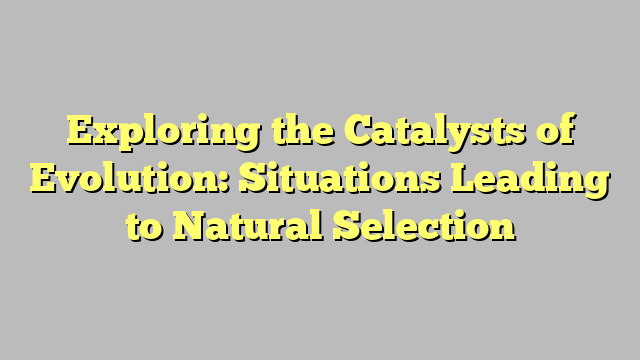Exploring the Catalysts of Evolution: Situations Leading to Natural Selection
Exploring the Catalysts of Evolution: Situations Leading to Natural Selection
Evolution, a fundamental concept in biology, is driven by various factors that influence the genetic makeup of organisms over generations. Among these, natural selection plays a pivotal role. This article delves into the situations and catalysts that lead to natural selection, shaping the course of evolution.
Understanding Natural Selection
Natural selection is the process by which species adapt to their environment to survive and reproduce. It acts on the genetic variation within populations, favoring traits that enhance survival and reproductive success. Over time, these advantageous traits become more common in the population.
The Mechanisms of Natural Selection
- Variation: Genetic differences among individuals in a population.
- Inheritance: Traits must be heritable to be passed on to the next generation.
- Differential Survival and Reproduction: Individuals with advantageous traits are more likely to survive and reproduce.
Key Catalysts of Evolutionary Change
Several factors act as catalysts for evolutionary change, leading to natural selection. These include environmental changes, mutation, gene flow, and genetic drift.
Environmental Changes
Changes in an organism’s environment can create new challenges and opportunities, driving natural selection. These changes can be:
- Climatic shifts: Changes in temperature, precipitation, and other climatic factors.
- Geographical alterations: Changes in the landscape, such as the formation of mountains or rivers.
- Biological factors: Introduction of new predators, prey, or competitors.
Mutation
Mutations are changes in the DNA sequence of an organism. While most mutations are neutral or harmful, some can provide individuals with an advantage in certain environments, fueling natural selection.
Gene Flow
Gene flow, or the transfer of genes between populations, introduces new genetic material into a population. This can increase genetic variation and potentially introduce traits that are advantageous in a particular environment.
Genetic Drift
Genetic drift refers to random changes in the frequency of alleles (versions of a gene) in a population. Although not a selective process, genetic drift can lead to the loss or fixation of alleles, indirectly affecting natural selection.
Examples of Natural Selection in Action
Natural selection can be observed in various contexts, from antibiotic resistance in bacteria to the evolution of camouflage in animals.
Antibiotic Resistance in Bacteria
Bacteria can evolve rapidly due to their short generation times. The overuse of antibiotics has led to the selection of resistant strains, demonstrating natural selection’s role in the evolution of resistance mechanisms.
Camouflage in Animals
Animals that can blend into their environment are less likely to be seen by predators, increasing their chances of survival and reproduction. This selective pressure has led to the evolution of camouflage in various species.
Conclusion
Natural selection is a powerful force in evolution, driven by various catalysts such as environmental changes, mutation, gene flow, and genetic drift. By understanding these catalysts, we gain insights into the mechanisms of evolution and the dynamic nature of life on Earth.
References
| Author | Title | Year |
|---|---|---|
| Darwin, Charles | On the Origin of Species | 1859 |
| Dobzhansky, Theodosius | Genetics and the Origin of Species | 1937 |
| Mayr, Ernst | Systematics and the Origin of Species | 1942 |

